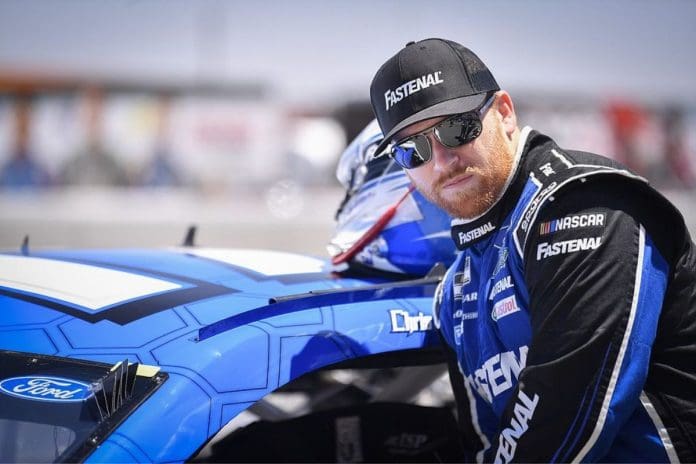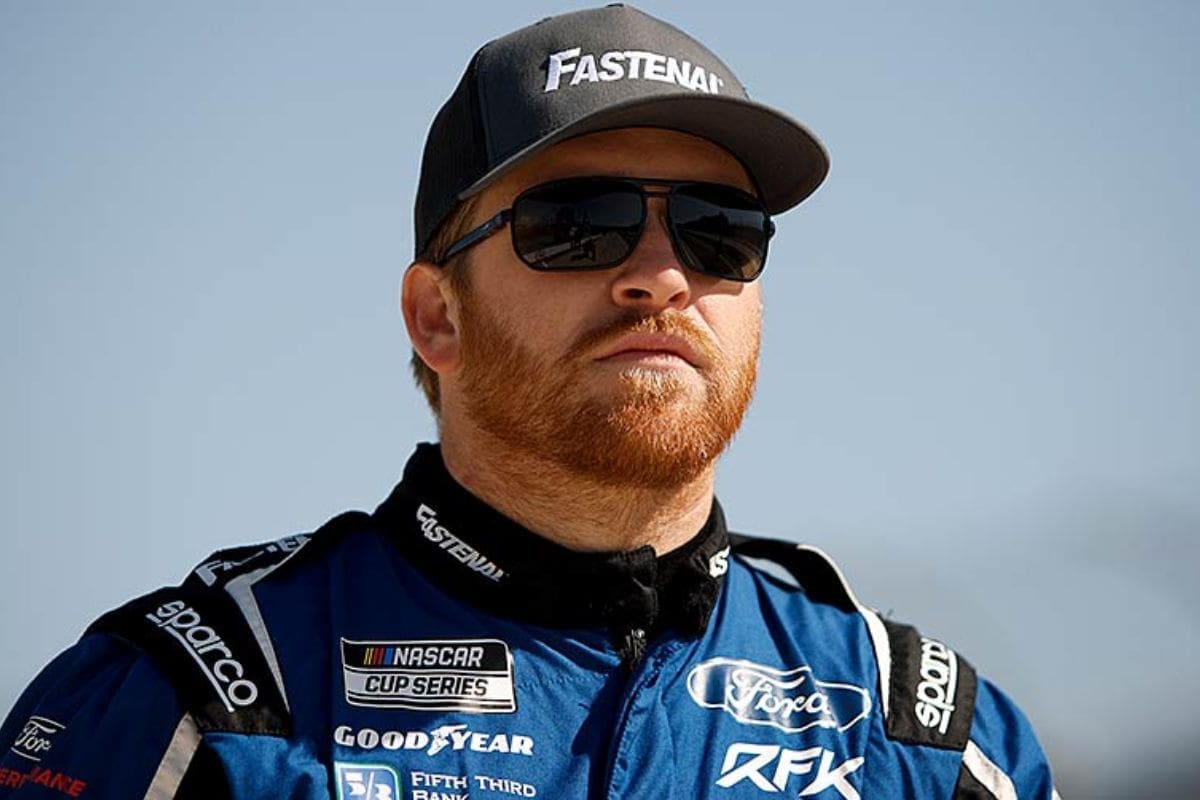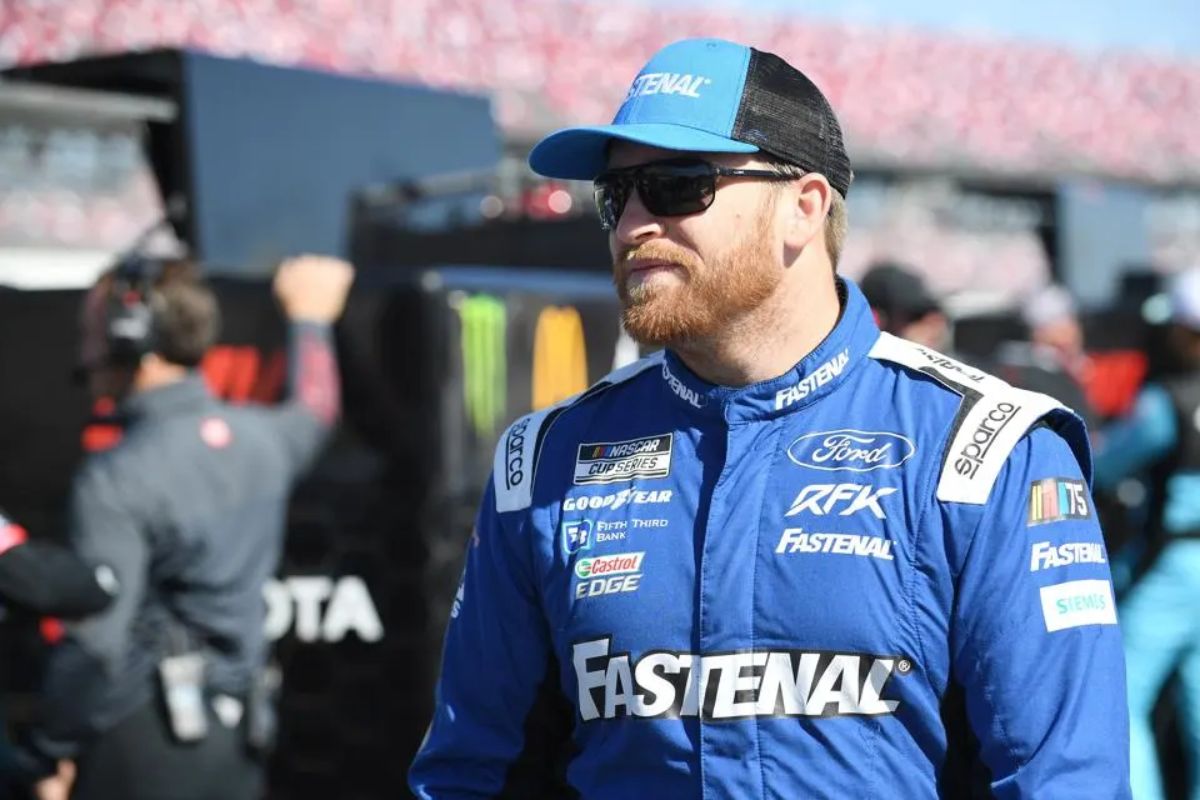.NASCAR Insiders Hide Kansas Blunder: In the latest NASCAR event at Kansas Speedway, the race’s finale has sparked significant controversy, primarily due to what many insiders are suggesting was a critical oversight involving the start-finish line. Chris Buescher, who missed out on a victory by a mere 0.001 seconds, has expressed profound disappointment, raising questions about the accuracy and reliability of NASCAR’s scoring system. This incident not only casts a shadow over the race’s legitimacy but also initiates a conversation about the transparency and fairness of NASCAR’s competitive practices.
Key Takeaways
- The crooked start-finish line at Kansas Speedway controversially impacted the race’s outcome, leaving Buescher just 0.001 seconds short of victory.
- Discussions about the fairness and integrity of the racing conditions ensued due to the architectural anomalies affecting critical judgments.
- Advanced finish line technology and NASCAR’s scoring system typically ensure precise race outcomes, but questions arose about their application in this instance.
- Rain delays added complexity to the race dynamics, potentially influencing the fairness of the competition.
- Despite the setback, Buescher remains focused and determined for upcoming races, specifically at the challenging Darlington Raceway.
The Kansas Speedway Controversy: Buescher’s Heartbreak
At the recent Kansas Speedway race, a mere fraction of a moment—0.001 to be exact—was all that separated Chris Buescher from a potential victory, culminating in a controversial and disheartening finish. This infinitesimal time gap, one of the closest in NASCAR history, emphasizes not only the competition inherent in the sport but also highlights the significant impact of external factors such as the raceway’s design and unforeseen weather conditions.
The race’s end was tainted by a rare occurrence: a crooked start-finish line, which, due to its unusual positioning, played a crucial role in the outcome. Such architectural anomalies can obscure clear judgments during critical moments, especially when races conclude with such tight margins. Additionally, the added complexity of a rain delay further complicated the race dynamics. This interruption, although necessary for safety, inevitably shifts the momentum and can alter the psychological preparedness of the drivers.
For Buescher and his team, the outcome was particularly stinging. Leading up to the final laps, strategic tactics and an exemplary display of skill positioned him as a frontrunner for the win. However, the combination of a non-standard track feature and the interruption caused by weather introduced variables that were beyond their control.
“I haven’t seen a replay other than just a picture… I sure can’t see it in that picture. That sucks to be that close. I still can’t see (it).” – Buescher
Expert Insights on the Finish Line Photo
Building upon the complexities of the race’s outcome, former crew chiefs Steve Letarte and Todd Gordon reveal the advanced technology used to determine the winner at such close finishes. In the fast-paced world of NASCAR, where milliseconds can separate victory from defeat, the accuracy of finish line technology is paramount. Gordon detailed the sophisticated systems involved, which include high-speed cameras and digital imaging tools that capture the precise moment when a car crosses the finish line. This technology, akin to what is used in other high-velocity sports, guarantees that even the closest races can be adjudicated fairly and accurately.
“This isn’t a picture. That’s why the background is kind of blurred here because the picture is taking anything that’s moving… So the wall, the line, the racetrack. They’re not moving. Those slices get blurred together… And this is the same technology used across many different sporting events.” – gordon
Letarte emphasized that this technology is not unique to NASCAR but is also prevalent in other racing disciplines such as IndyCar. The integration of such high-tech equipment is critical in maintaining the integrity of the sport, allowing for definitive visual evidence in tight finish scenarios. He explained that these tools operate on a frame-by-frame analysis, which can pinpoint the exact position of each vehicle at the pivotal moment of crossing the finish line.
Letarte and Gordon Clarify the Situation
In their detailed analysis, Letarte and Gordon addressed public concerns by clarifying how the finish line technology operates and its crucial role in guaranteeing precise race outcomes. They emphasized that this technology is not exclusive to NASCAR but is a vital component in different sports where milliseconds can determine winners.
Letarte explained that the integration of such technology is imperative to preserve the integrity of the sport. He recognized the frustrations of fans, especially in close finishes like the recent event in Kansas, but highlighted the necessity of such systems to provide indisputable results. Gordon, adding to this, pointed out that without such technology, the potential for human error in judgment could lead to inconsistencies and disputes that might tarnish the sport’s credibility.
“I think that’s a point worth clarifying… This isn’t a NASCAR thing. IndyCar uses it, NASCAR uses it, Kentucky Derby uses it, the Olympics use it… Really anything that is trying to determine the winner at a finish line uses this type of technology. The most important part of this is the finish of the race. It is not to be debated or argued. I agree that the start-finish line could be more defined.”
“I agree with all of the sentiments that I hear from the fans out there and some of the frustration. But it’s clear…”
“So NASCAR has determined that the loops and the transponders will be used to score the field from, basically the entire race.” – letarte
.@SteveLetarte and @ToddBGordon break down the process of determining a winner in a photo finish. pic.twitter.com/KGqAGws65Z
— NASCAR (@NASCAR) May 7, 2024
This highlights the technologies across different sports, reinforcing Letarte’s point about its significance. By using such technologies, sports leagues ensure that every participant’s performance is recorded with the highest accuracy, leaving little room for error and ensuring that the rightful winners are celebrated. This not only enriches the viewing experience but also upholds the sports’ integrity and fairness.
NASCAR’s Scoring and Timing System Explained
Following their clarification on the general use of finish line technology, Letarte and Gordon provided an in-depth look at NASCAR’s specific scoring and timing system, emphasizing the roles of timing loops and transponders. This sophisticated arrangement is designed to deliver precise and indisputable race results, important for the integrity of the sport.
“NASCAR has determined when we’re going to use loops, and that is all race long until we pay points, which is the finish of the stages. Or (at) the finish of the race we’ll go back to the high-speed cameras.” – gordon
“We saw the #17 of Chris Buescher’s team basically celebrating. That’s because the electronics and the loops put him in front of Kyle Larson when they crossed the line… And that’s you know, basically the difference between the electronic timing and scoring in the camera itself. That’s really the point of this whole conversation, just like in the Kentucky Derby, just like in the Olympics….” – Letarte
At the heart of NASCAR’s scoring system are the timing loops, which are embedded at different points around the track. These loops work in conjunction with transponders installed on each vehicle. As a car passes over a loop, the transponder sends a signal that records the exact time and position of the car.
High-speed cameras positioned at the finish line complement these systems. They provide a visual confirmation of the positions as cars cross the line—a critical backup to the electronic data collected by the transponders and timing loops.
- Timing Loops and Transponders: Ensure continuous, real-time tracking of each car’s position and lap count.
- High-Speed Finish Line Cameras: Offer a fail-safe visual record for finishes that are too close to call through transponder data alone.
- Data Integration and Analysis: Sophisticated software integrates data from both systems, allowing for immediate race results and detailed post-race analysis.
Looking Ahead to Darlington: Buescher’s Determination
Despite the setback at Kansas Speedway, Chris Buescher remains resolute in his pursuit of a win at the upcoming Darlington Raceway event. His perseverance is a testament to his resilience and focus, characteristics that are vital in the environment of NASCAR racing. As the series moves to one of its most challenging tracks, Buescher’s strategic approach and his team’s preparation will be key in tackling the notorious ‘Lady in Black.’
Darlington Raceway, with its unique egg-shaped oval design and abrasive surface, demands exceptional skill and car handling. The track’s wear on tires and its tendency for causing accidents place additional demands on drivers and their teams to execute flawlessly. For Buescher, this means a focus on tire management and race pacing, areas where he has shown proficiency in past races. His ability to conserve his car’s resources while remaining competitive through the race’s stages will be crucial.
News in Brief: NASCAR Insiders Hide Kansas Blunder
The controversy surrounding the Kansas Speedway race emphasizes the necessity for NASCAR to improve the precision and transparency of its scoring and timing systems. The minimal margin that decided the race’s outcome highlights the crucial need for accurate adjudication in competitive racing.
As the series progresses, such advancements are vital to maintaining the integrity of the sport and ensuring that all competitors, including Buescher, are afforded fair opportunities to claim victories based solely on performance and merit.
Our Reader’s Queries
Q. Where did Chris Buescher finish?
A. At Kansas Speedway Sunday night, Chris Buescher showcased an impressive performance, leading the Ford pack with a commendable second-place finish. However, Buescher found himself on the less fortunate end of NASCAR lore, narrowly missing out on victory as Kyle Larson secured a photo finish win. The margin between them, a mere 0.001 seconds, etched itself into the annals of NASCAR Cup Series history as the closest recorded finish to date.
Q. Who is Chris Buescher married to?
A. Following his race at Kansas Speedway, Chris Buescher headed back to North Carolina to reunite with his wife Emma and daughter Charley. His return to family comes ahead of the upcoming Daytona 500, with plans for Buescher to resume his racing duties on Sunday morning. During his absence, fellow Roush Fenway Keselowski Racing driver David Ragan will take the wheel of Buescher’s No. [Car Number].
Q. Has Buescher ever won a NASCAR race?
A. On November 21, 2015, Chris Buescher clinched a milestone victory in his NASCAR career, securing his first-ever NASCAR Xfinity Series Championship. The memorable achievement unfolded at Homestead Miami Speedway during the final race of the 2015 season, marking a significant moment in Buescher’s racing journey.
ALSO READ: Fans Boycott NASCAR Over Talladega Incident Fallout





